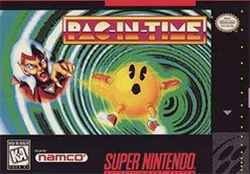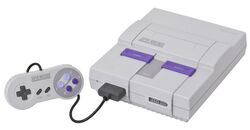Software:Pac-In-Time
| Pac-In-Time | |
|---|---|
 North American SNES cover art | |
| Developer(s) | Kalisto Entertainment |
| Publisher(s) | Namco |
| Composer(s) | Frédéric Motte |
| Series | Pac-Man |
| Platform(s) | Super Nintendo Entertainment System, Game Boy, MS-DOS, Mac OS |
| Release | SNES, Game Boy
|
| Genre(s) | Platform |
| Mode(s) | Single-player |
Lua error in Module:Lang/utilities at line 332: attempt to call field '_transl' (a nil value). is a platform game developed by Kalisto and published by Namco, featuring the arcade character Pac-Man. It was released in 1995 for MS-DOS, Macintosh, Super Nintendo Entertainment System, and Game Boy.
This game was an offshoot from the normal variety of Pac-Man games, in that it does not confine Pac-Man to a maze-like board. Rather, the player controls Pac-Man through various side-scrolling levels, obtaining many different items along the way; the plot does take elements from the earlier Pac-Man games, such as the objective to collect a certain number of pellets before exiting a level. The game allows the player to access completed levels via passwords that are given every five levels.
The game is a rebranded version of a 1993 game, Fury of the Furries, also developed by Kalisto. The PC, Macintosh and Game Boy versions are almost identical to the original, while the Super NES game, despite using the same basic gameplay mechanics, is an entirely new game using a different game engine and aesthetic.
Gameplay
In Pac-In-Time, players control Pac-Man in his mission to return to the present day after his nemesis, the Ghost Witch, cast a spell that transported him to his youth in 1975, five years before his debut appearance.[1] The game spans the course of five different worlds with 10 levels each.[1] Levels are designed around solving puzzles and backtracking to previous sections, taking place in environments such as mountains, villages, and castles.[1] The objective of each level is to collect all of the pellets, or "Pac-Dots", found throughout to open up an exit door.[1] Each level contains around 30 Pac-Dots each, with a counter displayed at the bottom-left of the screen that indicates how many remain.[1] Enemies and obstacles are found throughout that will cause Pac-Man to lose a portion of his life-bar when touched.[1] The Ghosts also appear and will give chase to Pac-Man; he can defeat them by eating a Power Pellet, which will cause them to turn blue and edible.[1][2]
Pac-Man can collect four different items to aid him in his quest, each having different effects when used.[1] These items can be found by jumping through colored hoops in levels; Pac-Man can hold all four of them at once, but can only use one at a time.[1] Jumping through the hoop a second time will remove the item from the player's inventory.[1] These items are the rope, which can latch onto ceilings and can allow Pac-Man to swing himself to higher places, and can also be used to push objects; the fireball, which allows Pac-Man to spit deadly fireballs at enemies; the hammer, which allows Pac-Man to smash objects; and the swim shoes, which grant Pac-Man the ability to swim underwater.[1] Pac-Man can also replenish his health by eating fruit found throughout levels, and can also find items such as 1-ups in treasure chests, which can be opened by finding a key.[1] In the final level, Pac-Man will face off against the Ghost Witch, and defeating her will allow him to be sent back to the present.[1]
Development and release
Pac-In-Time was designed by Kalisto Entertainment, a French video game studio headed by business entrepreneur Nicolas Gaume. Assisting production was Namco Hometek, the North American console game division of Japanese company Namco.[3] Namco Hometek also served as the publisher for the game. Pac-In-Time is a reskin and rebranding of Kalisto's older game Fury of the Furries, a puzzle platformer originally released for Amiga, Macintosh and MS-DOS in 1994.[4] Namco licensed the game's engine from Mindscape, the parent company of Kalisto.[4] Namco, who had attempted to get a foothold into the European game market on multiple occasions, decided to make the game a Pac-Man platformer due to the character's worldwide appeal.[5]
Pac-In-Time was developed for the Super Nintendo Entertainment System (SNES), Game Boy, Mac OS, and MS-DOS. While the Game Boy and computer versions are simply Fury of the Furries with a Pac-Man skin, the SNES version is an entirely new game with altered levels and themes, while still keeping the same mechanics and concepts intact. The Japanese Super Famicom version was changed to be harder than its international counterparts, adding instant-death traps and generally making levels more difficult and challenging.[5] Pac-In-Time is billed as a follow-up to Pac-Man 2, which was released earlier in 1994.[6]
Pac-In-Time was first released on January 3, 1995 for the Super Nintendo Entertainment System and Game Boy.[7] The Macintosh and MS-DOS versions were published a month later. The magazine Sega Visions announced a Sega Genesis version of the game slated for an October 1995 release, however this version was never published.[8] A Game Gear version was also cancelled, designed by Gil Espeche;[4] this version has since been dumped online by the video game preservation group SMS Power in 2005.[4]
An emulated version of the Japanese Super Famicom version is included in the compilation title Pac-Man Museum +. Despite being emulated, the game was modified to replace/alter the designs of Pac-Man's family in the introductory and epilogue cutscenes, with Ms. Pac-Man and Baby Pac-Man being replaced with the Pac-Mom and Pac-Sis characters created for the collection, while the design of Jr. Pac-Man (named Pac-Boy) is slightly altered. While not officially stated why the changes were made, it is assumed to be tied with Ms. Pac-Man's ongoing AtGames dispute.[9]
Reception
| Reception | ||||||||||||||||
|---|---|---|---|---|---|---|---|---|---|---|---|---|---|---|---|---|
| ||||||||||||||||
Pac-In-Time was met with a generally favorable reception from publications, and is seen as a unique and innovative title in the Pac-Man series. GamePro magazine commented that it helps represent the character's legacy, and that it was an interesting take on the franchise.[10] The Super Famicom version sold 21,265 copies in its first week on the market.[14]
The game's visuals and presentation were praised by several. Electronic Gaming Monthly liked Pac-Man's cute design and for the game itself having a distinctly-cute style, while also praising the graphics themselves for being bright and colorful, which GamePro agreed with.[10] Reviewing the Game Boy version, Famitsu and Total! Germany said that the graphics had a very cartoony look, but were average for the system.[7][12] Critics also praised the game's controls and items;[3][11] GamePro in particular said that together they "breathed new life into a classic character."[10] GamePro and VideoGames both enjoyed the rope item for being fun to use.[10][13] Electronic Gaming Monthly liked the music but said it became repetitive after a while.[3]
The gameplay was well-received, particularly for its usage of puzzle-solving. GamePro described it as a "fun, fast-paced adventure".[10] Electronic Gaming Monthly said that it "has the makings of a great game" through its pick-up-and-play approach and for the game being generally fun to play.[3] Next Generation and VideoGames agreed, both of whom enjoyed the level design for its usage of puzzle-solving.[11][13] Famitsu liked the gameplay for being entertaining and the stages for being wide-open and fun to explore, although said that the puzzle-solving can become repetitive after a while.[7] By contrast, Next Generation felt that the level design became repetitive and lack in variety between them, which they stated was the game's only weakness.[11] Most critics felt that the game became too difficult later on,[11][7][10] with Electronic Gaming Monthly in particular disliking the learning curve for being overly-high.[3] Total! Germany praised the Game Boy version for its creativity and design, but claimed that its difficulty would put off younger players and only recommended the game towards more dedicated platform fans.[12] Video Games magazine said that Pac-In-Time was a significant step-up in quality compared to the series' previous platform outings, writing: "Pac-Man fans will dig the characters and the familiar theme music at the opening of each stage, but Pac-In-Time really has little to do with the maze game that launched a thousand maze games. However, unlike Pac-Land - a previous attempt to blend the Pac-Man universe with a platform-game scenario - this one is a pleasantly addictive romp that knows just how to tease players into coming back for more."[13]
Notes
References
- ↑ 1.00 1.01 1.02 1.03 1.04 1.05 1.06 1.07 1.08 1.09 1.10 1.11 1.12 Pac-In-Time Super Nintendo Entertainment System instruction manual. USA: Namco. 3 January 1995. https://www.gamesdatabase.org/Media/SYSTEM/Nintendo_SNES//Manual/formated/Pac-in-Time_-_1995_-_Namco_Limited.pdf. Retrieved 1 March 2020.
- ↑ "Pac-In-Time" (in de). Club Nintendo. 7. Nintendo of Europe. May 1995. pp. 18–19. https://archive.org/stream/ClubNintendo1995German/Club_Nintendo_1995_3#page/n9/mode/2up/search/Pac-In-Time.
- ↑ 3.0 3.1 3.2 3.3 3.4 3.5 "Review Crew: Pac-In-Time". Electronic Gaming Monthly (Sendai Publishing) (68): 34. March 1995.
- ↑ 4.0 4.1 4.2 4.3 Gasking, Frank (2005). "Games That Weren't: Pac-In-Time". Retro Gamer. United Kingdom: Imagine Publishing. p. 75. https://archive.org/stream/retro_gamer/RetroGamer_017#page/n69/mode/2up/search/time.
- ↑ 5.0 5.1 QTQ (2017). スーパーファミコンクソゲー番付. Myway Publishing. p. 113. ISBN 9784865117097.
- ↑ "Prescreen - Kalisto". Edge. Future plc. April 1997. pp. 42–45. https://archive.org/details/EDGE.N044.1997.04/page/n41/mode/2up?q=nicolas+gaume+pac-in-time.
- ↑ 7.0 7.1 7.2 7.3 7.4 "パックインタイム (GB)". Famitsu (Kadokawa Corporation). https://www.famitsu.com/cominy/?m=pc&a=page_h_title&title_id=13012&redirect=no. Retrieved 1 March 2020.
- ↑ "Incoming - October". Sega Visions (IDG) (25): 96. September 1995. https://archive.org/details/Sega-Visions-Issue-25#page/n99/mode/1up.
- ↑ "SwitchArcade Round-Up: 'Pac-Man Museum+', 'Kao the Kangaroo', Plus Today's Other New Releases and Sales – TouchArcade" (in en-US). 27 May 2022. https://toucharcade.com/2022/05/27/pac-man-museum-plus-kao-the-kangaroo-switch-eshop-price-deal-panzer-dragoon-remake-discount-nintendo/.
- ↑ 10.0 10.1 10.2 10.3 10.4 10.5 10.6 Nade, Sarah (April 1996). "Proreview - Pac-In-Time". GamePro. International Data Group. p. 66. https://archive.org/details/GamePro_Issue_069_April_1995/page/n67/mode/2up.
- ↑ 11.0 11.1 11.2 11.3 11.4 "Pac-In-Time". Next Generation (Imagine Media) (6): 113–4. June 1995. https://archive.org/details/nextgen-issue-006/page/n125/mode/2up.
- ↑ 12.0 12.1 12.2 CH (August 1995). "Game Boy - Pac In Time" (in de). Total! Germany. https://total.bee-ware.ch/tests/gb/gb_PacInTime.jpg.
- ↑ 13.0 13.1 13.2 13.3 Bieniek, Chris (April 1995). "Super NES - Pac-In-Time". VideoGames. Larry Flynt Publications. p. 68. https://archive.org/details/Video_Games_The_Ultimate_Gaming_Magazine_Issue_75_April_1995/page/n59/mode/2up/search/Pac-In-Time?q=Pac-In-Time.
- ↑ "Game Search (based on Famitsu data)". 1 March 2020. https://sites.google.com/site/gamedatalibrary/game-search.
External links
 |



